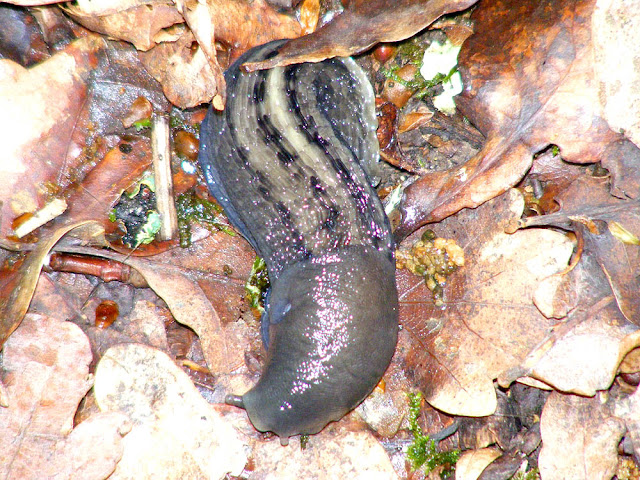The other day when biodiversity surveying at La Gendronniere I came across some really huge molluscs. These two pictured are both the largest ones of their species that I have ever seen.
 |
| Roman Snail Helix pomatia (Fr. Escargot de Bourgogne). |
Roman Snails are widely distributed, all over France, except for Brittany, Corsica, and a few other coastal areas. This is the species that is most likely to be served up to you on a plate in a restaurant if you order escargots. It's a protected species in the wild, with strict seasonal rules about when and how it can be harvested in France, so the ones on the menu have come from Eastern Europe (Hungary and Poland mostly). It is completely forbidden to collect them from the wild in April, May and June. At other times of the year, specimens of more than 3 cm diameter may be taken. Many of the wild ones get an extra layer of protection because they occur on Natura 2000 sites, with active conservation management plans to ensure their survival. Natura 2000 is a European network of core breeding and resting sites for rare and threatened species, and some rare natural habitat types which are protected in their own right.
They live in forests and open habitat, gardens and vineyards, and occur naturally anywhere there is high humidity, calcareous soil and cool temperatures. This one was photographed in the potager (kitchen garden) of the Chateau de la Gendronniere. Individuals are not very mobile, never moving more than about 6 metres from where they were hatched. They are vulnerable to the land being drained or cleared for cultivation, and to over harvesting. Their diet is mostly fresh green plants, but also some decaying plant material. They need the soil to be high in calcium in order to make their shells. The snails become sexually mature from 2 years old and can live as long as 10 years.
 |
| Ash-black Slug Limax cinereoniger (Fr. Grande limace). |
The Ash-black Slug is the largest species of land slug in the world, occasionally reaching a whopping 30 cm when fully extended. This one was big, but not that big! I photographed it on a path along the edge of woodland at the back of the Chateau. They are a forest species, quite susceptible to changes in their habitat. Although widely distributed, they only occur in very favourable undisturbed habitat, so they are quite localised. They eat algae, fungi and decaying plant material. They are very variable in appearance, and often much darker than this one, without the stripes except for a pale keel along their back. When in doubt about a big dark grey slug's identity you need to turn it over. If it is an Ash-black Slug its foot will have a clearly delineated pale central stripe.
We are also on Instagram, so check us out to see a regularly updated selection of our very best photos. You may also like to check out our YouTube channel.

1 comment:
Bill has taken pictures of slugs in the US, UK and France, but we've never seen this one. We will have to be on the lookout next visit. There is something fascinating about the creatures.
Post a Comment